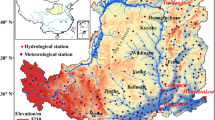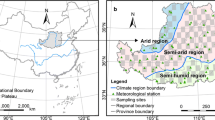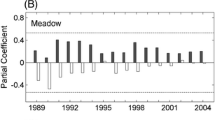Abstract
Understanding the dynamics of vegetation system change is often limited by relatively brief data sequences and the shortage of comparable analyses of variation over longer periods. In this study, GIMMS NDVI and MODIS NDVI datasets were integrated to establish a consistent NDVI time series from 1982 to 2012 on vegetation of the Tibetan Plateau in China. The spatiotemporal patterns of change in seasonal NDVI and their linkage with climatic variables were analyzed at regional and pixel scales over 14 periods ranging from 18 to 31 years and beginning in 1982. On a regional scale, positive trends of growing season and seasonal NDVI were observed during the 14 periods, and the increases were statistically significant for growing season NDVI during all periods, and for summer and autumn NDVI during only the last four and the last two periods, respectively. The rates of NDVI increase in growing season and spring significantly decreased over the 14 periods. NDVI rates slightly decrease in summer and significantly increase in autumn. At a pixel scale, areas with significant greening or significant browning significantly increased over the 14 periods during the growth season and during all seasons except spring, in which the proportion of vegetated area with greening rapidly decreased. Temperature was the primary climatic driver for the observed vegetation changes during multiple periods while precipitation and sunshine duration had significant impacts on vegetation growth only in limited parts of the study area or during spring. Vegetation growth response to climate change varied across seasons and regions. Trend analysis during the multiple nested time series provides a better understanding of NDVI dynamics and may help to forecast future changes. Spring NDVI is likely to continue decreasing, autumn NDVI will continue increasing, and the magnitude of the NDVI increase during growing season will decline in the future.









Similar content being viewed by others
References
Beck PSA, Goetz SJ (2011) Satellite observations of high northern latitude vegetation productivity changes between 1982 and 2008: ecological variability and regional differences. Environ Res Lett 6:5501–5511
Beck HE, McVicar TR, van Dijk AIJM, Schellekens J, de Jeu RAM, Bruijnzeel LA (2011) Global evaluation of four AVHRR–NDVI data sets: intercomparison and assessment against Landsat imagery. Remote Sens Environ 115:2547–2563. doi:10.1016/j.rse.2011.05.012
Brown ME, Pinzon JE, Didan K, Morisette JT, Tucker CJ (2006) Evaluation of the consistency of long-term NDVI time series derived from AVHRR, SPOT-vegetation, SeaWiFS, MODIS, and Landsat ETM + sensors. IEEE Trans Geosci Remote Sens 44:1787–1793. doi:10.1109/TGRS.2005.860205
Chen Y, Long B, Pan X, Zhong S, Mo H (2011) Differences between MODIS NDVI and AVHRR NDVI in monitoring grasslands change. J Remote Sens 15:831–845
China ECfVMo (2001) Vegetation Atlas of China. Science Press, Beijing
Cuo L, Zhang Y, Wang Q, Zhang L, Zhou B, Hao Z, Su F (2012) Climate change on the Northern Tibetan Plateau during 1957–2009: spatial patterns and possible mechanisms. J Clim 26:85–109. doi:10.1175/JCLI-D-11-00738.1
de Jong R, de Bruin S, Schaepman M, Dent D (2011) Quantitative mapping of global land degradation using Earth observations. Int J Remote Sens 32:6823–6853. doi:10.1080/01431161.2010.512946
de Jong R, Verbesselt J, Schaepman ME, de Bruin S (2012) Trend changes in global greening and browning: contribution of short-term trends to longer-term change. Glob Change Biol 18:642–655. doi:10.1111/j.1365-2486.2011.02578.x
Ding M, Zhang Y, Liu L, Wang Z (2010) Temporal and spatial distribution of grassland coverage change in Tibetan Plateau since 1982. J Nat Resour 25:2114–2122
Du J, Shu J, Wang Y, Li Y, Zhang L, Guo Y (2014) Comparison of GIMMS and MODIS normalized vegetation index composite data for Qinghai-Tibet Plateau. Chin J Appl Ecol 25:533–544
Duan A, Li F, Wang M, Wu G (2011) Persistent weakening trend in the spring sensible heat source over the Tibetan Plateau and its impact on the Asian summer monsoon. J Clim 24:5671–5682. doi:10.1175/JCLI-D-11-00052.1
Duan A, Wang M, Lei Y, Cui Y (2012a) Trends in summer rainfall over China associated with the Tibetan Plateau sensible heat source during 1980–2008. J Clim 26:261–275. doi:10.1175/JCLI-D-11-00669.1
Duan A, Wu G, Liu Y, Ma Y, Zhao P (2012b) Weather and climate effects of the Tibetan Plateau. Adv Atmos Sci 29:978–992. doi:10.1007/s00376-012-1220-y
Fensholt R, Rasmussen K, Nielsen TT, Mbow C (2009) Evaluation of earth observation based long term vegetation trends—intercomparing NDVI time series trend analysis consistency of Sahel from AVHRR GIMMS. Terra MODIS SPOT VGT Data Remote Sens Environ 113:1886–1898. doi:10.1016/j.rse.2009.04.004
Fensholt R, Langanke T, Rasmussen K, Reenberg A, Prince SD, Tucker C, Scholes RJ, Le QB et al (2012) Greenness in semi-arid areas across the globe 1981–2007—an earth observing satellite based analysis of trends and drivers. Remote Sens Environ 121:144–158. doi:10.1016/j.rse.2012.01.017
Fontana FMA, Coops NC, Khlopenkov KV, Trishchenko AP, Riffler M, Wulder MA (2012) Generation of a novel 1 km NDVI data set over Canada, the northern United States, and Greenland based on historical AVHRR data. Remote Sens Environ 121:171–185. doi:10.1016/j.rse.2012.01.007
Gallo K, Ji L, Reed B, Eidenshink J, Dwyer J (2005) Multi-platform comparisons of MODIS and AVHRR normalized difference vegetation index data. Remote Sens Environ 99:221–231. doi:10.1016/j.rse.2005.08.014
Goetz SJ, Bunn AG, Fiske GJ, Houghton RA (2005) Satellite-observed photosynthetic trends across boreal North America associated with climate and fire disturbance. Proc Natl Acad Sci 102:13521–13525
He Y, Fan G, Zhang X, Liu M, Gao D (2012) Variation of vegetation NDVI and its response to climate change in Zhejiang Province. Acta Ecol Sin 32:4352–4362
Huang L, Liu J, Shao Q, Liu R (2011) Changing inland lakes responding to climate warming in Northeastern Tibetan Plateau. Clim Change 109:479–502. doi:10.1007/s10584-011-0032-x
Huete A, Didan K, Miura T, Rodriguez EP, Gao X, Ferreira LG (2002) Overview of the radiometric and biophysical performance of the MODIS vegetation indices. Remote Sens Environ 83:195–213. doi:10.1016/S0034-4257(02)00096-2
Jeong S-J, Ho C-H, Gim H-J, Brown ME (2011) Phenology shifts at start vs. end of growing season in temperate vegetation over the Northern Hemisphere for the period 1982–2008. Glob Change Biol 17:2385–2399. doi:10.1111/j.1365-2486.2011.02397.x
Liu X, Wang Y (2011) Contrasting impacts of spring thermal conditions over Tibetan Plateau on late-spring to early-summer precipitation in southeast China. Atmos Sci Lett 12:309–315. doi:10.1002/asl.343
Mao F, Lu Z, Zhang J, Hou Y (2007) Relations between AVHRR NDVI and climate factors in northern Tibet in recent 20 years. Acta Ecol Sin 27:3198–3205
Mao D, Wang Z, Luo L, Ren C (2012) Integrating AVHRR and MODIS data to monitor NDVI changes and their relationships with climatic parameters in Northeast China. Int J Appl Earth Obs Geoinf 18:528–536. doi:10.1016/j.jag.2011.10.007
Mohammat A, Wang X, Xu X, Peng L, Yang Y, Zhang X, Myneni RB, Piao S (2013) Drought and spring cooling induced recent decrease in vegetation growth in Inner Asia. Agric Forest Meteorol 178–179:21–30. doi:10.1016/j.agrformet.2012.09.014
Myneni RB, Keeling CD, Tucker CJ, Asrar G, Nemani RR (1997) Increased plant growth in the northern high latitudes from 1981 to 1991. Nature 386:698–702. doi:10.1038/386698a0
Peng S, Chen A, Xu L, Cao C, Fang J, Myneni RB, Pinzon JE, Tucker CJ et al (2011) Recent change of vegetation growth trend in China. Environ Res Lett 6:4027–4029
Peng J, Dong W, Yuan W, Zhang Y (2012a) Responses of grassland and forest to temperature and precipitation changes in Northeast China. Adv Atmos Sci 29:1063–1077. doi:10.1007/s00376-012-1172-2
Peng J, Liu Z, Liu Y, Wu J, Han Y (2012b) Trend analysis of vegetation dynamics in Qinghai-Tibet Plateau using Hurst Exponent. Ecol Ind 14:28–39. doi:10.1016/j.ecolind.2011.08.011
Piao S, Cui M, Chen A, Wang X, Ciais P, Liu J, Tang Y (2011a) Altitude and temperature dependence of change in the spring vegetation green-up date from 1982 to 2006 in the Qinghai-Xizang Plateau. Agric Forest Meteorol 151:1599–1608. doi:10.1016/j.agrformet.2011.06.016
Piao S, Wang X, Ciais P, Zhu B, Wang TAO, Liu JIE (2011b) Changes in satellite-derived vegetation growth trend in temperate and boreal Eurasia from 1982 to 2006. Glob Change Biol 17:3228–3239. doi:10.1111/j.1365-2486.2011.02419.x
Qin J, Yang K, Liang S, Guo X (2009) The altitudinal dependence of recent rapid warming over the Tibetan Plateau. Clim Change 97:321–327. doi:10.1007/s10584-009-9733-9
Shen M, Zhang G, Cong N, Wang S, Kong W, Piao S (2014) Increasing altitudinal gradient of spring vegetation phenology during the last decade on the Qinghai-Tibetan Plateau. Agric Forest Meteorol 189–190:71–80. doi:10.1016/j.agrformet.2014.01.003
Shichang K, Yanwei X, Qinglong Y, Wolfgang-Albert F, Nick P, Tandong Y (2010) Review of climate and cryospheric change in the Tibetan Plateau. Environ Res Lett 5:015101
Steven MD, Malthus TJ, Baret F, Xu H, Chopping MJ (2003) Intercalibration of vegetation indices from different sensor systems. Remote Sens Environ 88:412–422. doi:10.1016/j.rse.2003.08.010
Sun H, Zheng D, Yao T, Zhang Y (2012) Protection and construction of the national ecological security shelter zone on Tibetan Plateau. Acta Geogr Sin 67:3–12
Tucker C, Pinzon J, Brown M, Slayback D, Pak E, Mahoney R, Vernote E, Saleous NE (2005) An extended AVHRR 8-km NDVI dataset compatible with MODIS and SPOT vegetation NDVI data. Int J Remote Sens 26:4485–4498. doi:10.1080/01431160500168686
van Leeuwen WJD, Orr BJ, Marsh SE, Herrmann SM (2006) Multi-sensor NDVI data continuity: uncertainties and implications for vegetation monitoring applications. Remote Sens Environ 100:67–81. doi:10.1016/j.rse.2005.10.002
Xu W, Gu S, Zhao X, Xiao J, Tang Y, Fang J, Zhang J, Jiang S (2011) High positive correlation between soil temperature and NDVI from 1982 to 2006 in alpine meadow of the Three-River Source Region on the Qinghai-Tibetan Plateau. Int J Appl Earth Obs Geoinf 13:528–535. doi:10.1016/j.jag.2011.02.001
Xu X, Piao S, Wang X, Chen A, Ciais P, Myneni RB (2012) Spatio-temporal patterns of the area experiencing negative vegetation growth anomalies in China over the last three decades. Environ Res Lett 7:35701
Xu G, Zhang H, Chen B, Zhang H, Innes J, Wang G, Yan J, Zheng Y et al (2014) Changes in vegetation growth dynamics and relations with climate over China’s landmass from 1982 to 2011. Remote Sens 6:3263–3283
Yang Y, Piao S (2006) Variations in grassland vegetation cover in relation to climatic factors on the Tibetan Plateau. J Plant Ecol 30:1–8
Yang J, Ding Y, Chen R (2005) NDVI relation of alpine vegetation changes in the Source Regions of the Yangtze and Yellow rivers. Acta Geogr Sin 60:467–478
Yang K, Guo X, He J, Qin J, Koike T (2010) On the climatology and trend of the atmospheric heat source over the Tibetan Plateau: an experiments-supported revisit. J Clim 24:1525–1541. doi:10.1175/2010JCLI3848.1
Yang K, Ye B, Zhou D, Wu B, Foken T, Qin J, Zhou Z (2011) Response of hydrological cycle to recent climate changes in the Tibetan Plateau. Clim Change 109:517–534. doi:10.1007/s10584-011-0099-4
Yang K, Wu H, Qin J, Lin C, Tang W, Chen Y (2014) Recent climate changes over the Tibetan Plateau and their impacts on energy and water cycle: a review. Global Planet Change 112:79–91. doi:10.1016/j.gloplacha.2013.12.001
Yu H, Xu J, Okuto E, Luedeling E (2012) Seasonal Response of Grasslands to Climate Change on the Tibetan Plateau. PLoS One 7:e49230. doi:10.1371/journal.pone.0049230
Zhang G, Ouyang H, Zhang X, Zhou C, Xu X (2010) Vegetation change and its responses to climatic variation besed on eco-geographical regions of Tibetan Plateau. Geogr Res 29:2004–2016
Zhang G, Zhang Y, Dong J, Xiao X (2013) Green-up dates in the Tibetan Plateau have continuously advanced from 1982 to 2011. Proc Natl Acad Sci. doi:10.1073/pnas.1210423110
Zhao X, Tan K, Zhao S, Fang J (2011) Changing climate affects vegetation growth in the arid region of the northwestern China. J Arid Environ 75:946–952. doi:10.1016/j.jaridenv.2011.05.007
Acknowledgments
This study was supported by the National Natural Science Foundation of China (Grant 41001055), the Special Fund of Environment Protection Research in the Public Interest (Grant 201209027-5) and the Fundamental Research Funds for the Central Public-interest Scientific Institution (Grant 2009KYYW10 and 2012-YSKY-13). The authors thank the NASA Global Inventory Modeling and Mapping Studies (GIMMS) group for producing and sharing the AVHRR GIMMS NDVI datasets. NASA/MODIS Land Discipline Group is thanked for sharing the MODIS LAND data.
Author information
Authors and Affiliations
Corresponding author
Rights and permissions
About this article
Cite this article
Du, J., Zhao, C., Shu, J. et al. Spatiotemporal changes of vegetation on the Tibetan Plateau and relationship to climatic variables during multiyear periods from 1982–2012. Environ Earth Sci 75, 77 (2016). https://doi.org/10.1007/s12665-015-4818-4
Received:
Accepted:
Published:
DOI: https://doi.org/10.1007/s12665-015-4818-4




